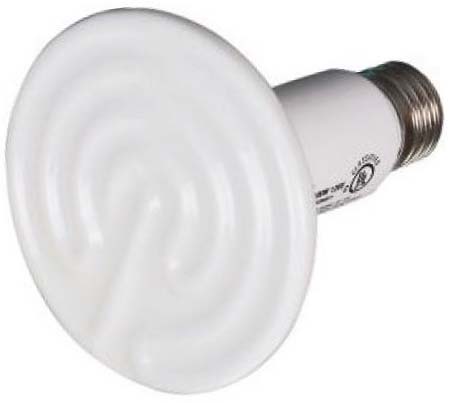
.
Related Reading
.
Kinds of Reptile Heat Bulbs: Ceramic Heat Emitters (CHEs)
Ceramic heat emitters (CHEs) are the one kind of heat bulb that gives off no light at all.
Actually they aren't really bulbs. But you screw them into lamp fixtures like a bulb, so we're covering them under bulbs.
A CHE is basically a heating element covered in ceramic. Many are shaped similar to a basking bulb.
Also similar to a basking bulb, the heat doesn't travel too far from the emitter.
So one CHE can't heat a large enclosure (but then again, neither can one incandescent bulb in most cases). But it could overheat a small one.
You can use these with a dimmer or rheostat. So if you do have a small habitat, and even the lowest watt CHE makes it too hot, you can dial down the power.
Because they get so hot, it's important to always use them in a porcelain socket. They can melt plastic sockets. Using the wrong socket can also cause a fire.
But even when using a ceramic socket, make sure you don't exceed the wattage rating of the fixture. And some lamps (like the Zoo Med Mini Deep Dome) specifically state not to use CHEs in them. This means even if the CHE is a low enough wattage, it's not safe to use in that lamp fixture.
On the other hand, the Zoo Med Wire Cage Clamp Lamp Fixture is actually UL rated to use with ceramic heat emitters (or at least with Zoo Med's CHE). Assuming you like Zoo Med products, using those two items together can give you peace of mind that you're doing your best to keep your pet warm and safe.
If you're using a ceramic heat emitter, keep these other safety tips in mind, too:
- Periodically check to be sure the CHE is screwed tightly into the socket. It can cause a short circuit if it's loose.
- Use only outside the habitat, never inside it. And make sure the lamp fixture is secured. Depending on the kind you use, either clamped to the habitat or on a lamp stand.
- Use a screened cover on your habitat under the CHE. This can prevent it from falling into the habitat and starting a fire if an accident does happen. But don't use a glass cover. Glass could crack.
- Never touch the CHE while it's turned on. And give it time to cool off after turning it off. The heat a few inches away from the CHE may not seem like much, but the CHE itself can still be very hot.
- Do not set it up near flammable materials.
CHEs can last for several years. So even though they're expensive, when you consider the yearly cost, it's actually very reasonable.
Most reptile supply manufacturers make ceramic heat emitters. Here are a few choices for you to check out.